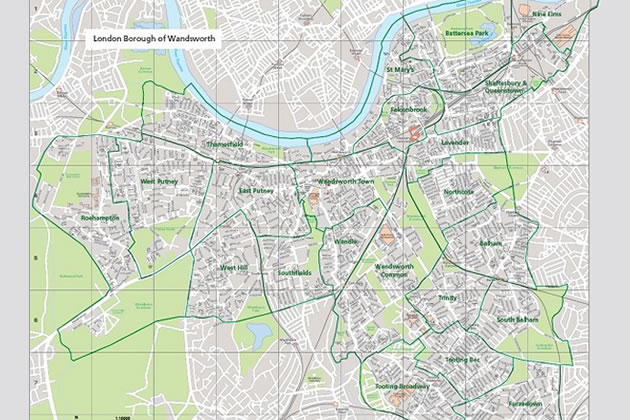Key Issues for Voters in Wandsworth Borough
Council will be hotly contested in the forthcoming election

New ward boundaries will be used for the first time. Picture: Wandsworth Council
April 28, 2022
On 5 May, voters across the UK will head to the polls to decide who will run their local authority.
One of the key battlegrounds in London is Wandsworth, where the Tories hold a slender majority.
Like at the last election in 2018, Wandsworth has been touted as a potential target for Labour this time round. Though the party did not take control of the council at the last election, Labour increased its number of seats, taking seven from the Conservatives and winning the popular vote.
Alongside other Tory strongholds such as Barnet and Westminster, Wandsworth was touted as a borough that could fall to Labour this year by Conservative peer and polling expert Lord Robert Hayward.
Polls have suggested that council tax bills and the wider cost of living crisis could be a significant factor in this year’s elections, something Labour will be hoping to capitalise on. But Labour won’t be able to rely on that attack line in Wandsworth – the only borough in London to cut council tax this year.
While council leader Ravi Govindia denied that the move was motivated by electoral concerns, it is likely to play well on the doorsteps ahead of election day.
The Conservatives will be hoping that their recent record of low council tax, a freeze on rents for council tenants and strong local services will outweigh public dissatisfaction with Boris Johnson and a voter base that elected three Labour MPs in 2019 and voted mostly in favour of Sadiq Khan in last year’s mayoral election.
While Labour has controlled Wandsworth London Borough Council in the past – one term from 1964 to 1968 and consecutive terms from 1971 to 1978 – the Conservatives have held a majority in the borough for the past four decades.
Described as Margaret Thatcher’s “favourite council”, Wandsworth was one of the first councils to begin outsourcing services such as street cleaning and waste collection to private firms, while the borough has typically always enjoyed low council tax bills.
But despite the borough’s reputation as a Tory stronghold, the Conservatives saw their majority on the council slashed at the last election in 2018 when they lost seven seats to Labour and one to an independent candidate.
Across the whole borough, Labour received more votes than the Conservatives in 2018, but as with in other boroughs, a concentration of support in specific wards meant that more votes did not automatically translate into more seats.
Overall, the Conservatives won 33 seats in 2018, just two more than the threshold required for a majority on the council. Labour won 26 seats, up from 19 in the previous election, while independent candidate Malcolm Grimston won one seat.
Turnout in 2018 was 43.62 per cent, higher than most other years since the turn of the millennium other than 2010 when local elections coincided with the General Election.
Following the findings of the Local Government Boundary Commission review in 2020, Wandsworth will be divided into 22 wards from this year’s election – up from 20 – while the number of seats on the council will decrease from 60 to 58.
In August 2021, Labour councillor Hannah Stanislaus resigned from the party before resigning from the council altogether having accused the Labour leadership of bullying. In the subsequent by-election in November, Labour candidate Sheila Boswell retained the seat for the party winning by just one vote over the Conservative candidate.
Just last month, Labour councillor Peter Carpenter was suspended by the party and barred from seeking re-election after he tweeted that Chancellor Rishi Sunak should “go back to India with his billionaire wife”.
In February 2022, Wandsworth became the only council in London to approve a council tax cut. While most boroughs increased council tax, some by as much as the 2.99 per cent maximum allowed by the Government, Wandsworth council agreed a 1 per cent cut to council tax bills earlier this year.
Wandsworth’s population is estimated to be around 329,735 according to 2020 figures from the Office for National Statistics. This is up from 306,995 as recorded in the 2011 Census.
According to City Hall estimates from 2020, Wandsworth has a higher proportion of residents aged between 16 and 64 compared to both the London and England averages. Approximately 72.9 per cent of Wandsworth’s population is comprised of working aged people, compared to a 68.5 per cent average across London and 62.2 per cent in England.
Just 17.5 per cent of the borough’s population is estimated to be aged 15 or under, compared to more than 19 per cent in London and England. Less than 10 per cent of Wandsworth’s population is aged 65 or above.
City Hall data from 2020 also estimates that Wandsworth has a lower proportion of residents from Black, Asian and Minority Ethnic backgrounds compared to the rest of London. Around 29.9 per cent of the borough’s population is made up of people from BAME backgrounds, compared to 43.5 per cent across the capital.
Overall, around 47.6 per cent of Wandsworth’s population is White British, while 19.5 per is from other White backgrounds. Just over 5 per cent of the borough’s population is made up of people from Black African backgrounds, while 3.5 per cent comes from Black Caribbean backgrounds.
People from Pakistani backgrounds make up an estimated 3.2 per cent of Wandsworth’s population, while people of Indian heritage make up 2.5 per cent. Just over 1 per cent of residents in the borough are from Arab backgrounds, while a further 1.1 per cent are from Chinese backgrounds. People from other Asian backgrounds make up 3 per cent of the population.
The poverty rate in Wandsworth is 22 per cent, rising to 31 per cent for child poverty. The unemployment rate for the borough is 4.3 per cent.
Joe Talora - Local Democracy Reporter